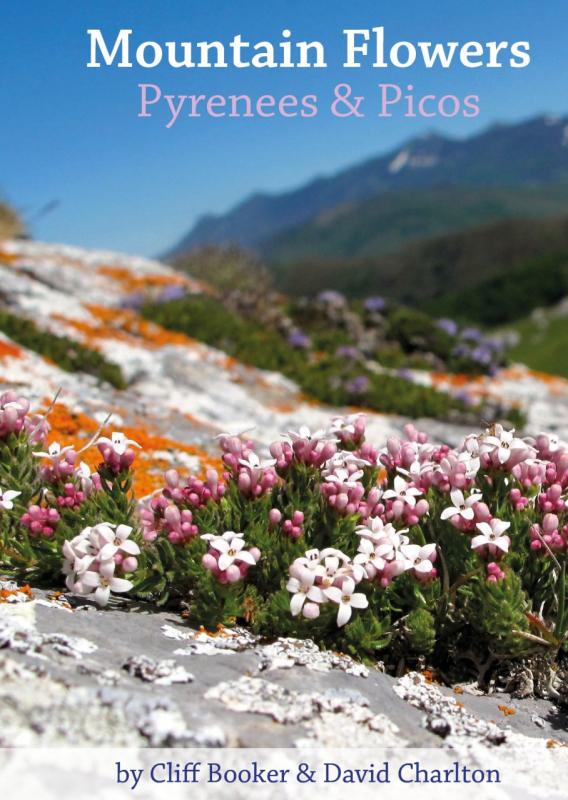Mountain Flowers: Pyrenees and Picos by Cliff Booker and David Charlton
Published in association with Collett’s Mountain Holidays in 2017. Available from the Alpine Garden Society book service. Currently unavailable on Amazon (March 2020)
This is a spiral bound field guide, published in 2017. The Pyrenees is the mountain range dividing France from Spain, with the Atlantic Ocean to the west and the Mediterranean Sea to the east. The Picos de Europa is a nearby range of mountains along the north coast of Spain. These ranges include both limestone areas and areas of acid rocks with different flora. The habitats or zones covered in the book include woodland, valley meadows (grazed by livestock), high mountain meadows, and lastly rocks, peaks and scree. Each zone in the book has an associated symbol, which identifies the zone where each plant is commonly found. The book has color photographs of each flower and is divided into sections by flower colors: blue (including blue violet), pink (including purply pink), red, yellow, and white. Each flower page is labeled with bloom time with the month(s) highlighted. Botanical name, plant family, and common name (in English, Spanish, and French) are all given. There is helpful text, which sometimes includes more specific information about the plant’s habitat, and whether the plant is a semi-parasite or parasite. Plant and flower size are not specified, however the user would likely be able to identify the plants in the book, provided they are in flower when seen.
Some critical comments:
The book is clearly organized, and the photos are good. It is not meant to be a comprehensive plant guide to the two mountain ranges, rather it includes many of the most showy or interesting flowering plants. It’s interesting to see the common name in three languages. The zone information would be most useful for finding and identifying the plants. Organization by color sections is also helpful to find a plant in the book. Some of the flower colors may be on the cusp of two sometimes different colors: is that flower violet/purple or is it pink/lavender pink? Sometimes two individuals perceive colors differently; I have had debates with others about the color of a flower before. Still, I wonder why the Ramonda with the violet flowers is included in the pink flower section (Ramonda can have pink flowers, but the photo is a violet flowered one). Surprisingly, the book is using archaic plant family names: Cruciferae, Labiatae, and Umbelliferae; current plant family names for those families are (in order as above) Brassicaceae (cabbage family), Lamiaceae (mint family), and Apiaceae (carrot family). More perplexing is that the book uses both archaic and current plant family names for the first two families mentioned in this topic. Plant family names were standardized decades ago to all end in ---aceae. The plant family name for the bean family, Fabaceae, is consistently misspelled Fabiaceae. Identification errors in the book were Euphorbia amygdaloides being identified in Liliaceae (correct family is Euphorbiaceae) and Sedum dasyphyllum is identified as Sedum album. In spite of the anomalies in the book, I enjoyed reading the book, and would gladly bring the book on a trip to the Pyrenees to use as a helpful guide.
John Gilrein is chairperson of the Adirondack chapter and has been a chapter member for 20 years. He is a pathological gardener, grows perennials, annuals, trees and shrubs, and has an expanding rock garden. He likes to travel to interesting places and hike, which is a great opportunity for botanizing. Some favorite botanizing destinations have been Colorado, Wyoming, California, the Bruce Peninsula, Croatia, and Kenya.

